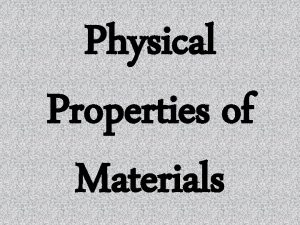Chap 2 Physical Properties u Materials properties 1
![Chap. 2. Physical Properties u Materials properties [1]: A material's property is an intensive, Chap. 2. Physical Properties u Materials properties [1]: A material's property is an intensive,](https://slidetodoc.com/presentation_image_h/1c3f49327bb10d1798c844ca4d05fbe7/image-1.jpg)
![Chap. 2. Physical Properties u Materials properties [2]: from internet A physical property is Chap. 2. Physical Properties u Materials properties [2]: from internet A physical property is](https://slidetodoc.com/presentation_image_h/1c3f49327bb10d1798c844ca4d05fbe7/image-2.jpg)


![Chap. 2. Physical Properties ~ CTE Bonding Energy ~Tm 부산대학교 재료공학부 [Potential Energy Well] Chap. 2. Physical Properties ~ CTE Bonding Energy ~Tm 부산대학교 재료공학부 [Potential Energy Well]](https://slidetodoc.com/presentation_image_h/1c3f49327bb10d1798c844ca4d05fbe7/image-5.jpg)






![Chap. 2. Physical Properties [Homework #2] / Due date: before next class 1. Define Chap. 2. Physical Properties [Homework #2] / Due date: before next class 1. Define](https://slidetodoc.com/presentation_image_h/1c3f49327bb10d1798c844ca4d05fbe7/image-12.jpg)
- Slides: 12
![Chap 2 Physical Properties u Materials properties 1 A materials property is an intensive Chap. 2. Physical Properties u Materials properties [1]: A material's property is an intensive,](https://slidetodoc.com/presentation_image_h/1c3f49327bb10d1798c844ca4d05fbe7/image-1.jpg)
Chap. 2. Physical Properties u Materials properties [1]: A material's property is an intensive, often quantitative, 1. Physical properties -Mechanical propertiesproperty of some materials. * Strength * Hardness * Toughness -Electrical Properties -Magnetic Properties -Optical Properties -Thermal Properties 2. Chemical properties -Corrosion -Oxidation, etc 부산대학교 재료공학부 [Material Properties] 계면공학 연구실
![Chap 2 Physical Properties u Materials properties 2 from internet A physical property is Chap. 2. Physical Properties u Materials properties [2]: from internet A physical property is](https://slidetodoc.com/presentation_image_h/1c3f49327bb10d1798c844ca4d05fbe7/image-2.jpg)
Chap. 2. Physical Properties u Materials properties [2]: from internet A physical property is any property that is measurable whose value describes a state of a physical system. A physical system is a portion of the physical universe chosen for analysis. 부산대학교 재료공학부 [Material Properties] 계면공학 연구실

Chap. 2. Physical Properties 중요: dotted curve 융점™, 열팽창계수 ( ), 탄성계수와 관계 (E) Fig. 2 -4. Energy vs. separation distance for two oppositely charged ions. 부산대학교 재료공학부 [Potential Energy Well] 계면공학 연구실

Chap. 2. Physical Properties u Potential Well Concept: shape of the energy well is important in determining several physical properties of the materials ü Elastic modulus ü Thermal properties ü Melting point Very important !! Fig. 2 -10. Potential energy well for atoms in a solid. 부산대학교 재료공학부 [Potential Energy Well] 계면공학 연구실
![Chap 2 Physical Properties CTE Bonding Energy Tm 부산대학교 재료공학부 Potential Energy Well Chap. 2. Physical Properties ~ CTE Bonding Energy ~Tm 부산대학교 재료공학부 [Potential Energy Well]](https://slidetodoc.com/presentation_image_h/1c3f49327bb10d1798c844ca4d05fbe7/image-5.jpg)
Chap. 2. Physical Properties ~ CTE Bonding Energy ~Tm 부산대학교 재료공학부 [Potential Energy Well] E: elastic modulus 계면공학 연구실

Chap. 2. Physical Properties u Melting temperature is determined mainly by the depth of the energy well, whereas the modulus is determined by the curvature at the bottom of the well. E 부산대학교 재료공학부 [Potential Energy Well] 계면공학 연구실

Chap. 2. Physical Properties u Mechanical Properties: mechanical properties of a material are those properties that involve a reaction to an applied load. Wear 부산대학교 재료공학부 [Mechanical Properties] 계면공학 연구실

Chap. 2. Physical Properties u Electrical properties are the physical conditions that allow an electrical charge to move from atom to atom in a specific material. These properties differ greatly between the three major types of materials: solids, liquids and gases. Thermal vibration Impurity effect Temp. 부산대학교 재료공학부 Content (%) [Electrical Properties] 계면공학 연구실

Chap. 2. Physical Properties u Magnetism is a class of physical phenomena that are mediated by magnetic fields. Electric currents and the fundamental magnetic moments of elementary particles give rise to a magnetic field, which acts on other currents and magnetic moments. Spin and orbital motion of electrons Operation principle 부산대학교 재료공학부 [Magnetic Properties] 계면공학 연구실

Chap. 2. Physical Properties u Optics is the branch of physics which involves the behavior and properties of light, including its interactions with matter and the construction of instruments that use or detect it. Effect of nanoparticles: distributions of non-agglomerated nanoparticles in a polymer are used to tune the index of refraction. Additionally, such a process may produce materials with non-linear optical properties. Gold or Cd. Se nanoparticles in glass lead to red or orange coloration. Semi-conducting nanoparticles and some oxide-polymer nanocomposites exhibit fluorescence showing blue shift with decreasing particle size. 부산대학교 재료공학부 [Optical Properties] 계면공학 연구실

Chap. 2. Physical Properties In physics, thermal conductivity (often denoted k, λ, or κ) is the property of a material to conduct heat. [LED or CPU] 부산대학교 재료공학부 [Thermal Properties] 계면공학 연구실
![Chap 2 Physical Properties Homework 2 Due date before next class 1 Define Chap. 2. Physical Properties [Homework #2] / Due date: before next class 1. Define](https://slidetodoc.com/presentation_image_h/1c3f49327bb10d1798c844ca4d05fbe7/image-12.jpg)
Chap. 2. Physical Properties [Homework #2] / Due date: before next class 1. Define hardness and describe its application. 2. Define toughness and describe its application. 3. Define light and describe its application. 4. Define heat and describe its application. 5. Define atom and describe its application. For each item, explain the content of 4~6 pages of ppts. [7분 발표 분량 ] 마치, 중학생들 20여명에게 쉽게 설명하는 강사가 되었다고 가정 부산대학교 재료공학부 계면공학 연구실
 Chap chap slide
Chap chap slide Physical properties of dental materials pdf
Physical properties of dental materials pdf Mixture of materials grade 6
Mixture of materials grade 6 Chemical property definition
Chemical property definition Favourite cars
Favourite cars Useful or harmful materials
Useful or harmful materials Man made materials
Man made materials Differentiate adopting materials and adapting materials
Differentiate adopting materials and adapting materials Direct materials budget with multiple materials
Direct materials budget with multiple materials Windbreaker chapter 1
Windbreaker chapter 1 Passion chap 6
Passion chap 6 Bank run chap 11
Bank run chap 11 Durbin chap
Durbin chap























